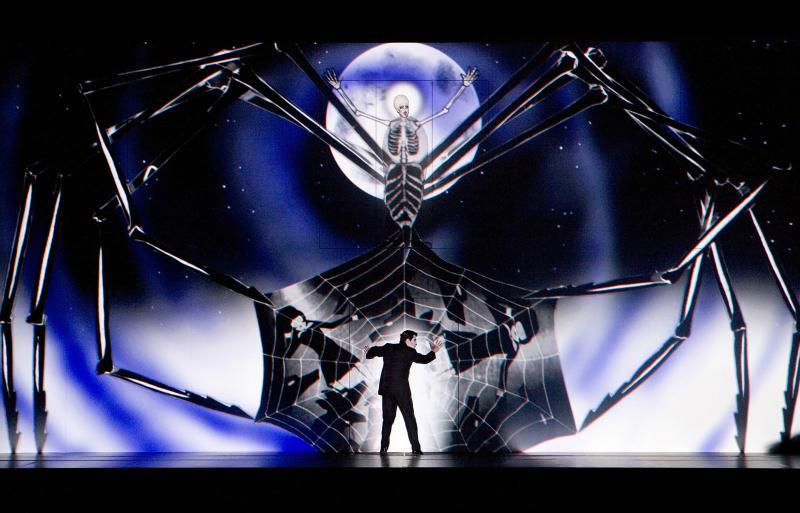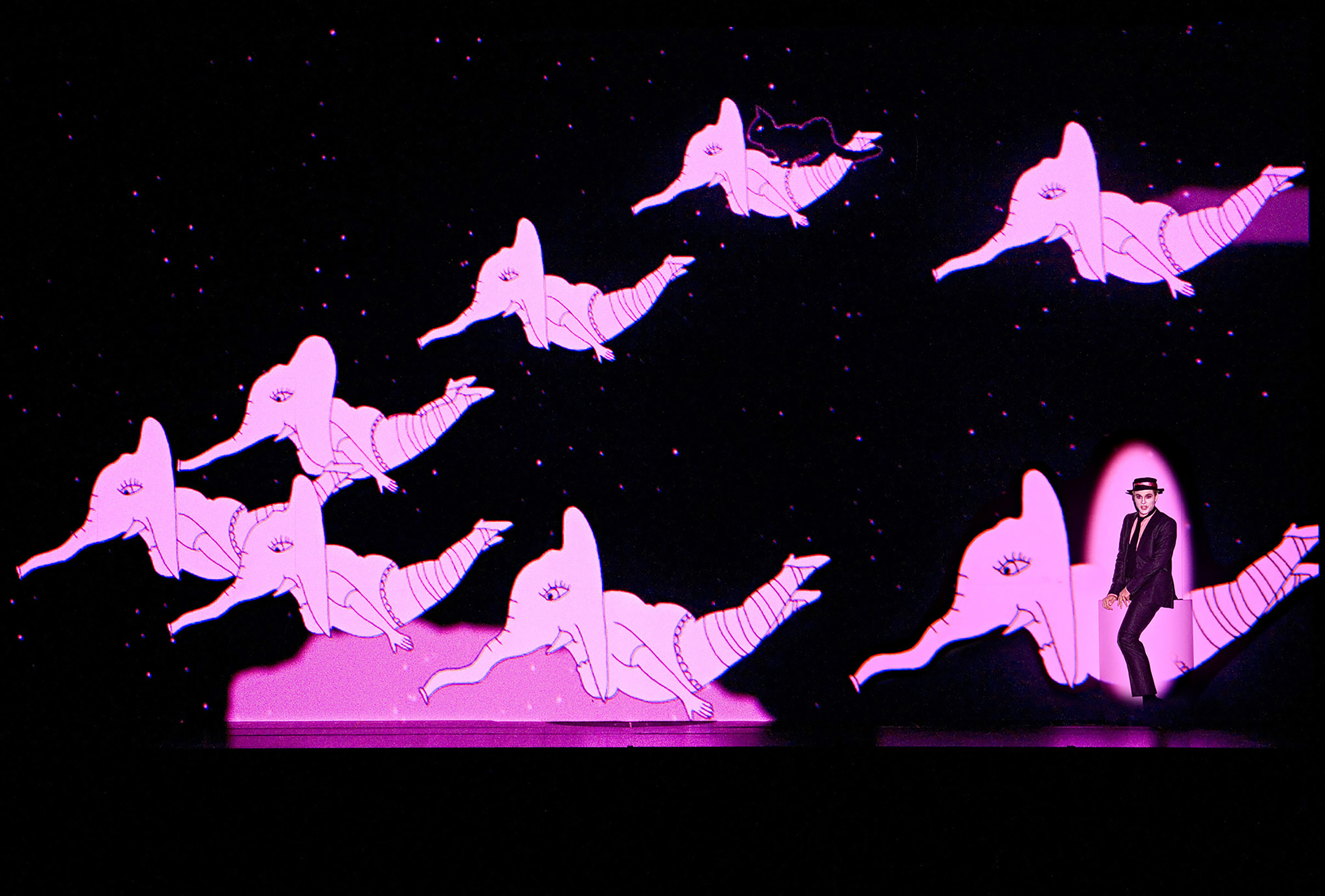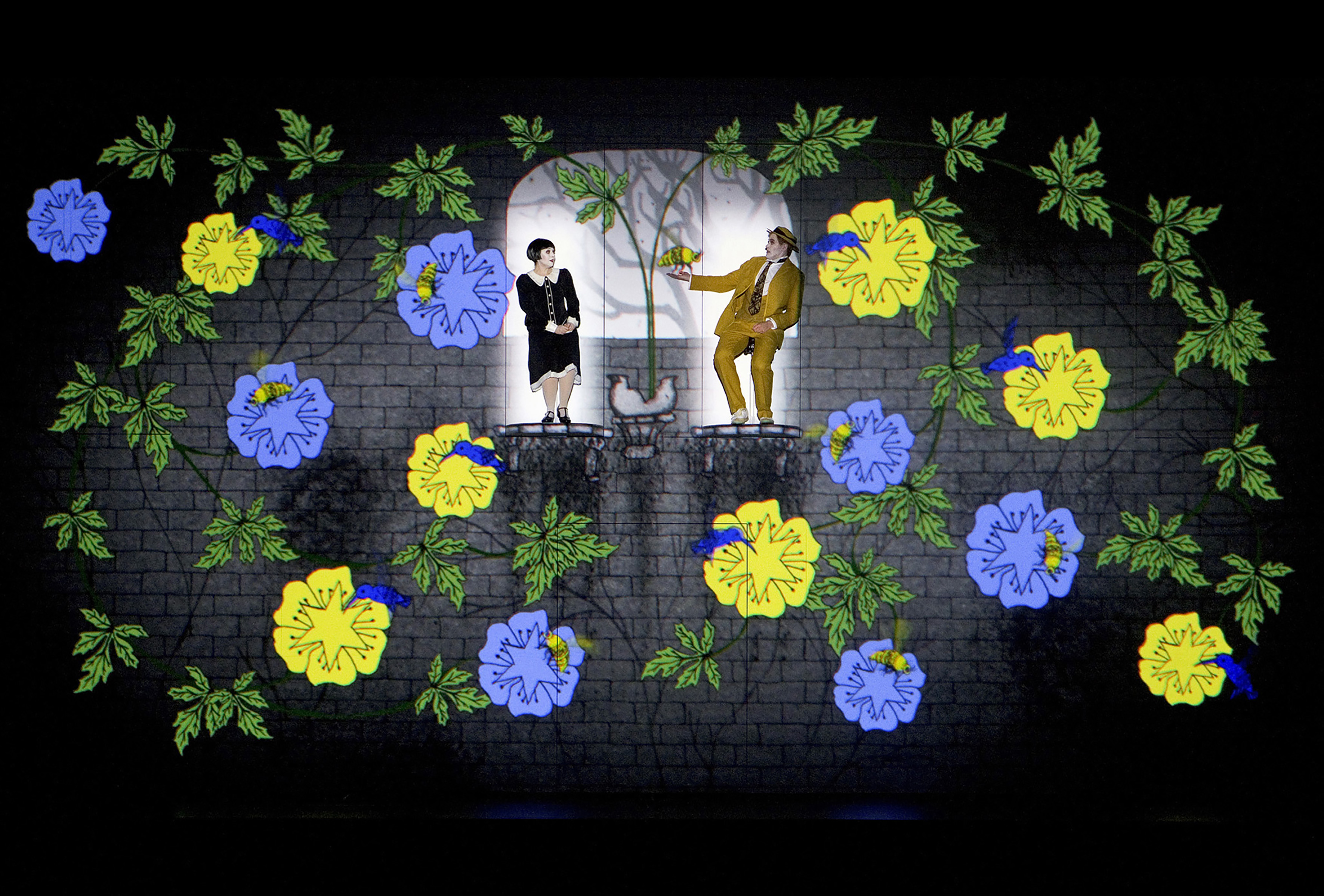The Magic Flute, Komische Oper Berlin, Edinburgh Festival Theatre | reviews, news & interviews
The Magic Flute, Komische Oper Berlin, Edinburgh Festival Theatre
The Magic Flute, Komische Oper Berlin, Edinburgh Festival Theatre
A magical Flute, but an insufficiently human one

In 2007, a tiny British theatre company called 1927 staged their first ever show at the Edinburgh Fringe – the darkly reimagined collection of fairytales and fables Between the Devil and the Deep Blue Sea. Now, almost a decade on, they are back where it all began – not at the Fringe but the Edinburgh International Festival, with their acclaimed Komische Oper production of The Magic Flute.
If you’ve seen any of 1927’s recent theatre work – The Animals and Children Took to the Streets or Golem – you’ll be familiar with an aesthetic that blends live action and animation to create dystopian worlds that are a little bit Weimar and a little bit punk, bladed humour cutting cleanly through political hypocrisy and social affectation. If Mozart’s kitschy-fantastical singspiel seems like an unlikely choice for their first opera, it’s an odd coupling that generates satisfying dramatic friction – even if they and director Barrie Kosky still can’t quite make sense of the awkward symbolism of the plot.
As a one-off it’s enchanting, a miraculous exercise in visual invention
In many ways this Magic Flute is 1927-lite. Happy endings and love-at-first-sight are the order of the day in a production that strips away all spoken dialogue to reimagine the show as a silent movie: Pamina a Louise Brooks bobbed heroine and Papageno a Buster Keatonish sidekick. What keeps it all from slipping into stylish pastiche is the renegade imagination of 1927 animator Paul Barritt.
Flying elephants, monsters in burlesque outfits, a laboratory of strange scientific contraptions and a Queen of the Night conceived as a giant spider are just some of the ideas flung out with joyous excess through the course of the evening, sheer creative energy and anarchy anchoring the show just the right side of sentimentality. Meticulously synchronised interactions between singers and animations free an opera too often incapable of realising the spectacle its plot demands, releasing it to become a freewheeling fantasy, with just a hint of philosophical bite.
 Sarastro (Dmitry Ivashchenko) becomes a stern Victorian gentleman, all bloodless propriety and big whiskers. He and his identikit followers try to lure Pamina and Tamino back into their proto-scientific world, covering the progressive Pamina up in a crinoline and repressing the young prince’s individuality in a stern uniform. Torn between regressive moral control on the one hand and the Queen of the Night’s animal violence on the other, the two choose love – though how we are to read their initiation into the cult remains unclear. A final tableau suggests that the young lovers do eventually manage to persuade Sarastro and his hangers-on round to their own point of view.
Sarastro (Dmitry Ivashchenko) becomes a stern Victorian gentleman, all bloodless propriety and big whiskers. He and his identikit followers try to lure Pamina and Tamino back into their proto-scientific world, covering the progressive Pamina up in a crinoline and repressing the young prince’s individuality in a stern uniform. Torn between regressive moral control on the one hand and the Queen of the Night’s animal violence on the other, the two choose love – though how we are to read their initiation into the cult remains unclear. A final tableau suggests that the young lovers do eventually manage to persuade Sarastro and his hangers-on round to their own point of view.
There’s no doubting the fertility and energy of 1927’s imagination here, and it all bodes well for their future show for the Royal Opera’s Linbury Studio Theatre, where they will be freed from the shackles of a pre-existing opera and will co-create together with composer Richard Ayres. But in terms of execution, this Edinburgh iteration of the production had a few issues.
You can see the logic of conductor Kristiina Poska’s vigorous, driving interpretation, but to be denied any moment of let-up or musical pause throughout the entire evening is to wilfully misread the score. Playful momentum is appealing and appropriate to the visuals of this production, but can only shine in contrast and juxtaposition with moments of stillness and greater intensity. On opening night singers and pit parted company more than once, with vocal entries snatched and almost missed on several occasions. The orchestra itself was a mixed bag – collectively a bit scrappy, but with individual contributions of tremendous beauty, including some exquisite flute solos.
 Vocally too, things were mixed. An outstanding Queen of the Night from Olga Pudova attacked her victims with glittering coloratura arrows, devastatingly precise, and was neatly supported by a stylish trio of Ladies (Nina Bernsteiner, Karolina Gumos and Ezgi Kutlu). She met her match in the even tone and resonant lower register of Ivashchenko’s Sarastro, giving us the musical grounding that Dominik Koninger’s Papageno – a light, flexible baritone – lacked. Maureen McKay’s Pamina (pictured above with Koninger) was a little on the blunt side, but any weakness here was more than made up for by Allan Clayton’s heroic and unusually masculine Tamino, power taking nothing away from the delicacy of his phrasing.
Vocally too, things were mixed. An outstanding Queen of the Night from Olga Pudova attacked her victims with glittering coloratura arrows, devastatingly precise, and was neatly supported by a stylish trio of Ladies (Nina Bernsteiner, Karolina Gumos and Ezgi Kutlu). She met her match in the even tone and resonant lower register of Ivashchenko’s Sarastro, giving us the musical grounding that Dominik Koninger’s Papageno – a light, flexible baritone – lacked. Maureen McKay’s Pamina (pictured above with Koninger) was a little on the blunt side, but any weakness here was more than made up for by Allan Clayton’s heroic and unusually masculine Tamino, power taking nothing away from the delicacy of his phrasing.
Ultimately, though, Kosky and 1927’s coup of a concept keeps a good production from ever reaching its full potential. By cutting spoken dialogue and anchoring characters in the static and distant drama of silent films, they deny these odd figures their humanity and development. Relationships sustained at a distance of some 10 metres across the stage cannot flourish, and however inventive and attractive the typography, captions cannot replace the emotion of spoken speech (however stilted).
This Flute certainly is magical, but human it is not. As a one-off it’s enchanting, a miraculous exercise in visual invention, but when 1927 next return to opera they will need to find the emotional substance to match their visual style.
- The Magic Flute is at the Edinburgh Festival Theatre until 30 August
rating
Share this article
The future of Arts Journalism
You can stop theartsdesk.com closing!
We urgently need financing to survive. Our fundraising drive has thus far raised £49,000 but we need to reach £100,000 or we will be forced to close. Please contribute here: https://gofund.me/c3f6033d
And if you can forward this information to anyone who might assist, we’d be grateful.

Subscribe to theartsdesk.com
Thank you for continuing to read our work on theartsdesk.com. For unlimited access to every article in its entirety, including our archive of more than 15,000 pieces, we're asking for £5 per month or £40 per year. We feel it's a very good deal, and hope you do too.
To take a subscription now simply click here.
And if you're looking for that extra gift for a friend or family member, why not treat them to a theartsdesk.com gift subscription?
more Opera
 Tosca, Welsh National Opera review - a great company reduced to brilliance
The old warhorse made special by the basics
Tosca, Welsh National Opera review - a great company reduced to brilliance
The old warhorse made special by the basics
 BBC Proms: The Marriage of Figaro, Glyndebourne Festival review - merriment and menace
Strong Proms transfer for a robust and affecting show
BBC Proms: The Marriage of Figaro, Glyndebourne Festival review - merriment and menace
Strong Proms transfer for a robust and affecting show
 BBC Proms: Suor Angelica, LSO, Pappano review - earthly passion, heavenly grief
A Sister to remember blesses Puccini's convent tragedy
BBC Proms: Suor Angelica, LSO, Pappano review - earthly passion, heavenly grief
A Sister to remember blesses Puccini's convent tragedy
 Orpheus and Eurydice, Opera Queensland/SCO, Edinburgh International Festival 2025 review - dazzling, but distracting
Eye-popping acrobatics don’t always assist in Gluck’s quest for operatic truth
Orpheus and Eurydice, Opera Queensland/SCO, Edinburgh International Festival 2025 review - dazzling, but distracting
Eye-popping acrobatics don’t always assist in Gluck’s quest for operatic truth
 MARS, Irish National Opera review - silly space oddity with fun stretches
Cast, orchestra and production give Jennifer Walshe’s bold collage their all
MARS, Irish National Opera review - silly space oddity with fun stretches
Cast, orchestra and production give Jennifer Walshe’s bold collage their all
 Káťa Kabanová, Glyndebourne review - emotional concentration in a salle modulable
Janáček superbly done through or in spite of the symbolism
Káťa Kabanová, Glyndebourne review - emotional concentration in a salle modulable
Janáček superbly done through or in spite of the symbolism
 Buxton International Festival 2025 review - a lavish offering of smaller-scale work
Allison Cook stands out in a fascinating integrated double bill of Bernstein and Poulenc
Buxton International Festival 2025 review - a lavish offering of smaller-scale work
Allison Cook stands out in a fascinating integrated double bill of Bernstein and Poulenc
 Tosca, Clonter Opera review - beauty and integrity in miniature
Happy surprises and a convincing interpretation of Puccini for today
Tosca, Clonter Opera review - beauty and integrity in miniature
Happy surprises and a convincing interpretation of Puccini for today
 Hamlet, Buxton International Festival review - how to re-imagine re-imagined Shakespeare
Music comes first in very 19th century, very Romantic, very French operatic creation
Hamlet, Buxton International Festival review - how to re-imagine re-imagined Shakespeare
Music comes first in very 19th century, very Romantic, very French operatic creation
 Falstaff, Glyndebourne review - knockabout and nostalgia in postwar Windsor
A fat knight to remember, and snappy stagecraft, overcome some tedious waits
Falstaff, Glyndebourne review - knockabout and nostalgia in postwar Windsor
A fat knight to remember, and snappy stagecraft, overcome some tedious waits
 Salome, LSO, Pappano, Barbican review - a partnership in a million
Asmik Grigorian is vocal perfection in league with a great conductor and orchestra
Salome, LSO, Pappano, Barbican review - a partnership in a million
Asmik Grigorian is vocal perfection in league with a great conductor and orchestra
 Semele, Royal Opera review - unholy smoke
Style comes and goes in a justifiably dark treatment of Handelian myth
Semele, Royal Opera review - unholy smoke
Style comes and goes in a justifiably dark treatment of Handelian myth

Add comment